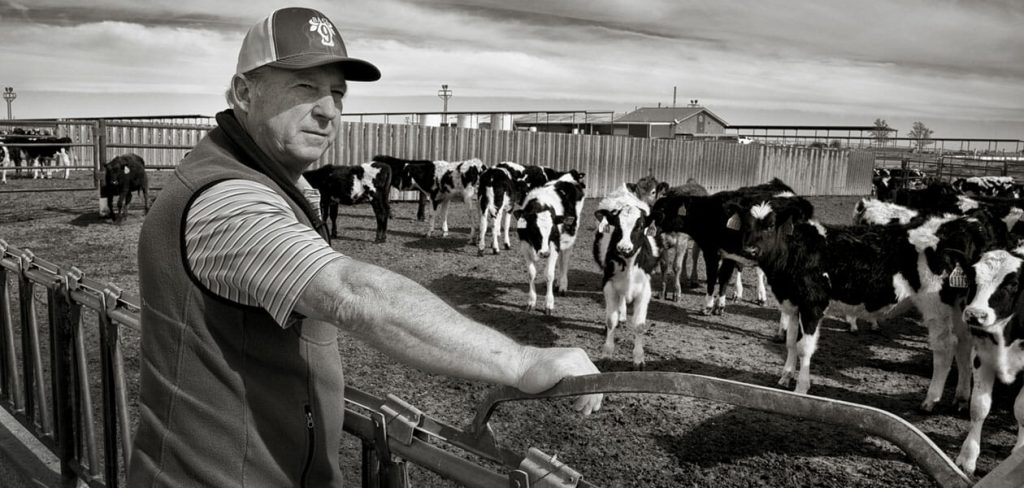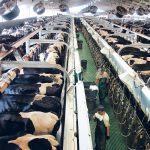
At Art Schaap’s dairy farm in Clovis, New Mexico, sprinklers draw from deep wells to water green fields of sorghum and corn. Near the milking barn Schaap built almost three decades ago, glossy black-and-white cows lap water from a pipe.
Schaap used to ship thousands of gallons of milk each day to milk co-ops and cheese producers, who in turn sold to consumers across the country. But for the last year he has poured all that milk down the drain.
In September 2018, Schaap got an unexpected visit from an official with Cannon Air Force Base, which adjoins his property. The official gave him a letter indicating that tests found his well water was contaminated with per- and polyfluoroalkyl substances (PFAS), a group of chemicals that have been linked to reproductive and developmental problems as well as cancer. The chemicals had migrated into Schaap’s groundwater from foams used in firefighting exercises on the military base.
Schaap and his family, the letter said, should immediately stop drinking the water.
Schaap, 54, is a third-generation dairy farmer. His family had farmed in the Netherlands and California before moving to New Mexico, and Schaap has been raising cows and crops here since 1992. Air Force officials told him they’d supply his family with bottled water. But he wondered about his cows.
“Milk is 90 percent water,” he thought.
“It kind of hit me like a rock,” he recalled in a recent interview, “that my cows are drinking this polluted water.”
Testing by the New Mexico Department of Agriculture showed that his milk was contaminated at levels 70 times above a federal advisory health limit for PFAS. The compounds are often called “forever chemicals” because they don’t break down and instead accumulate over time in the environment and the bodies of animals and humans.
When Schaap found out his water was polluted, neither the state Agriculture Department nor the Food and Drug Administration had a protocol for testing milk for PFAS — they developed a test expressly for his milk. When Schaap sent his first samples to the Agriculture Department for testing, he made the decision to dump his milk in order to avoid selling a potentially contaminated product.
Schaap has since laid off 35 employees, and his 4,000 cows — not to mention his family’s health and livelihood — are in limbo. Two other dairy farms in Clovis, a town of about 40,000 on the state’s eastern edge, were also found to have PFAS contamination in their groundwater, and others are concerned about the spreading plume.
Some Clovis dairy farmers have installed filtration systems on their wells, at a cost of about $260,000 per system, with yearly maintenance costs around $50,000. The Schaaps have not — the price is simply too high for the level of contamination in multiple wells, with no guarantee of adequate purification.
The farmers say the contamination is an “existential threat” not only to their livelihoods, but to the region’s economic future.
“Everything has changed,” Schaap said. “It’s not gonna ever be the same.”
PFAS contamination is a critical concern across the U.S., as the nonprofit Environmental Working Group estimates it has affected over 1,300 locations in 49 states, based on an analysis of state and federal records. That includes more than 400 military sites that used firefighting foam with PFAS compounds, according to the Pentagon.
Industrial manufacture of PFAS, which are used in products like waterproof clothing and nonstick pans, has caused contamination in North Carolina, Michigan, California, Colorado and elsewhere. A highly publicized case of PFAS contamination from a DuPont factory in West Virginia became the basis for the new Hollywood film “Dark Waters” starring Mark Ruffalo and Anne Hathaway. But Schaap’s case, which the small nonprofit news outlet Searchlight New Mexico highlighted earlier this year, is only the second known example of dairy contamination.
The effects of his farm’s contamination have rippled through the dairy industry, revealing a new vulnerability of the food supply. Most of the milk and other dairy products that Americans consume come from dairy cooperatives made up of thousands of smaller farmers like Schaap’s. In 2018, the top 50 dairy co-ops produced an estimated 81 percent of all milk sold.
PFAS chemicals were first developed in the 1940s as nonstick coatings for cookware, but their resistance to heat, water and oil soon led to widespread use in products like waterproof clothing and industries like electronics manufacturing. Over the last 20 years, a handful of PFAS compounds were phased out of production in the U.S., although they continue to be produced in other countries. Thousands of other PFAS compounds are still manufactured here.
Yet no enforceable federal regulatory level exists for PFAS in anything — water, air, soil or food.
That “advisory” level that New Mexico officials cited when they tested Schaap’s water was part of the Environmental Protection Agency’s “lifetime health advisory” for drinking water, which for now is the sole federal PFAS guideline. The EPA threshold is controversial. Some scientists consider it too high to be protective of human health, and because it’s only an advisory, federal regulators don’t enforce it. Out of a massive family of nearly 5,000 PFAS chemicals, with more created each year, the EPA advisory covers just two compounds.
Scientists are only beginning to study the presence of PFAS in food and agricultural products. The FDA developed tests for the presence of PFAS based on the EPA’s health advisory calculations and for the first time released results earlier this year. In a limited sampling, they tested packaged foods, fresh produce — and milk samples from Schaap’s farm.
The FDA concluded: “Overall, our findings did not detect PFAS in the vast majority of the foods tested. … The FDA does not have any indication that these substances are a human health concern, in other words a food safety risk in human food, at the levels found in this limited sampling.”
But scientists who study environmental contaminants question the FDA’s findings.
Tom Neltner, chemicals policy director at the nonprofit Environmental Defense Fund, has serious concerns about the FDA’s “broad conclusions” on food safety, given the limited scope of the agency’s testing and its methodology. Specifically, he said, the FDA’s definition of what constitutes a “detectable” level of PFAS was so restrictive that “it effectively underestimated the public’s exposure to PFAS.”
In its report, the FDA stated, “All milk from that [Schaap’s] farm was discarded and did not enter into the food supply.” Neltner calls the statement “odd” because, as he said, “The cows weren’t born yesterday.” Schaap’s milk had been sold nationwide for many years before the contamination was discovered. No one knows how long Schaap’s well water, and thus his milk, has been contaminated.
Linda Birnbaum, recently retired as director of the National Institute of Environmental Health Sciences, said she wishes the FDA had been “less definitive” with its conclusions. She’d like to see a larger array of foods surveyed from multiple communities across the country, and she noted that the tests measured just 16 PFAS compounds, leaving out the potential impact of thousands more chemicals.
An FDA spokesperson declined to be interviewed for this story. In a written response, the agency said, “Measuring PFAS concentrations in food, estimating dietary exposure and determining the associated health effects is an emerging area of science.”
Birnbaum thinks it’s too soon to say what level of PFAS exposure in food or water is “safe.” She said scientists need more information on people’s cumulative exposure to PFAS via food, water and even air in order to accurately evaluate the health impacts of any one source. “Is what we’re measuring giving us close to the total of chemicals in our blood,” Birnbaum asked, “or only giving us a small fraction of the total?”
Even very low doses of PFAS have been linked to decreased immune function, while other potential effects include high cholesterol and endocrine disruption as well as cognitive impairment in children.
A recent draft report from the Centers for Disease Control and Prevention calculated the safe levels for four PFAS chemicals to be roughly six times lower than the EPA advisory levels. And at a recent conference, Birnbaum cited a new study on pancreatic tumors in rats that suggests the safety threshold should be just 0.1 parts per trillion, or 700 times lower than the current advisory standard.
Scientists say that new findings on the health effects of PFAS should be taken into account and the EPA’s 2016 advisory should be updated. The EPA released an “action plan” in February that addresses monitoring and treatment of PFAS in drinking water, but it has not committed to creating new or enforceable standards. The agency also recently announced it has allocated $4.8 million to fund research into “managing” PFAS in rural areas and agriculture. The CDC just launched the first multi-site study to examine the health effects of PFAS exposure.
Given the uncertainty around federal PFAS limits for drinking water, several states are moving to create their own limits, ranging from 10 to 20 parts per trillion, and to regulate additional PFAS chemicals beyond the two included in the EPA standard. (New Mexico officials have said they are researching this option but haven’t said whether they will move forward with regulations.)
Birnbaum said this patchwork of regulation is confusing: “I think national coordination is where we’d all like to be.” She recommends an even stricter enforceable standard. “I’d like to see PFAS eliminated from drinking water,” she said.
Schaap never questioned the quality of his water until last year. “I felt like the water out of the faucet was the best thing for me,” he said. “It came out of my well, but I didn’t realize it was poisoning my body.”
Now Schaap is concerned about his health, though he said his only symptom is high cholesterol — which is among the potential effects of exposure to PFAS. Last year Schaap’s blood tested at 26 parts per billion for one PFAS compound, perfluorooctanoic acid (PFOA). According to a CDC study, the average blood level of PFOA in the general population is just two parts per billion. Six months after Schaap switched to purified water, the level had dropped only one point, he said.
“I’ve been exposed for years to PFAS,” he said, “and what really bugs me is they knew about it.”
According to Pentagon documents, officials found contamination in both on- and off-base wells at 39 active and former Air Force bases in 2017. In the wake of the discovery of groundwater contamination in Clovis, the state of New Mexico sued the Air Force in an effort to force it to clean up the pollution. It was the first state to take legal action. The lawsuit alleges that the Defense Department had identified a “PFAS crisis” as early as 2011.
It’s unknown when the chemicals used at Cannon Air Force Base began to leach into the local aquifer, although the Air Force has acknowledged that it has used firefighting foam with PFAS since 1970. The Air Force has thus far refused to clean up or even map the extent of the PFAS plume in Clovis.
An Air Force spokesman declined to be interviewed for this story. “We share community concerns about the possible impacts our firefighting mission may have on human drinking water sources,” he said in a written response. The statement says that in addition to supplying bottled water to Clovis residents, the Air Force is installing a water filtration system at another Clovis dairy farm for human use (though it has not at Schaap’s).
Schaap’s corn and sorghum crops, along with the soil across his 3,600 acres, are also contaminated after being irrigated with PFAS-laden well water for years, possibly decades.
So far, the Air Force has refused to install large-scale filtration systems for irrigation and livestock at affected farms. “Our first priority is protecting human drinking water,” it stated in its response, arguing that the EPA’s advisory levels for PFAS “are not appropriate for use in identifying risk levels for ingestion of food sources.”
Like the state, some in the Clovis community have turned to litigation as a recourse. This fall, the Curry County government approved a motion to sue the Defense Department for groundwater contamination. And Schaap himself is suing the Air Force for damages, as well as the manufacturers of PFAS chemicals.
Beyond Curry County, there’s increasing demand for federal solutions to both regulate PFAS exposure and clean up contaminated sites. Democrats in the U.S. House are pushing a legislative package that would require the EPA to set a drinking water standard for PFAS and require cleanup at military bases and other sites under the Comprehensive Environmental Response, Compensation and Liability Act of 1980, often called the Superfund program. While there is bipartisan support for addressing PFAS contamination, Senate Republicans, in particular, have been skeptical of an aggressive approach to PFAS regulation, so the fate of this effort is unclear.
Schaap is the only Clovis farmer to speak out publicly about the groundwater contamination, but he’s not the only one affected. The reliable water resources of the vast Ogallala aquifer, which stretches beneath eight states, drew many dairy farmers to the area. Curry County is the state leader in milk production and one of the top 20 counties nationally, with over $340 million in annual sales.
At least two other Clovis dairy farms have found PFAS in their well water at levels below the health advisory. Three other farmers joined Schaap in signing a letter to New Mexico Gov. Michelle Lujan Grisham asking the state to require the Air Force to treat water needed for irrigation and dairy operations and to control the migration of PFAS from the base into the groundwater.
Walter Bradley, a representative from the Dairy Farmers of America, the largest dairy marketing co-op in the nation, presented its concerns about PFAS to a meeting of the New Mexico legislature’s Radioactive and Hazardous Materials Committee in early November.
“It’s getting into the food chain,” Bradley told lawmakers. “And if you let it get into the food chain, you’ve got a major issue.”
Bradley is also concerned about the PFAS-contaminated groundwater moving toward one of the largest cheese plants in the world, Southwest Cheese, which is also located in Clovis and processes milk from many local dairy farms.
A year and a half ago, Schaap knew nothing about PFAS. He’s been forced to educate himself and has now traveled to Washington, D.C., to try to educate lawmakers.
“I’ve raised multiple generations of animals on this bad water,” he said. “It’s in their blood, it’s in their bodies, it’s in their meat.”
For now he’s using water from a small well adjacent to his farm for the cows and buying feed from another farm. The U.S. Department of Agriculture recently told him that if his cows test below a certain level of PFAS in their blood after a waiting period, he may be able to sell them for meat. He hopes he can avoid euthanizing them.
His farm is now “worth nothing,” Schaap said. He wants the government to buy his land and his water rights and to work to clean up the contamination. But he knows he’ll never raise cows or crops here again.























